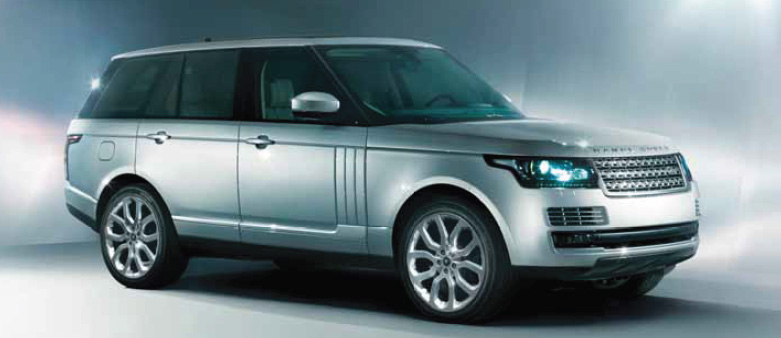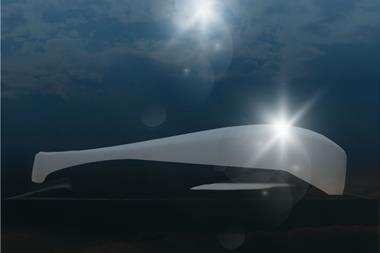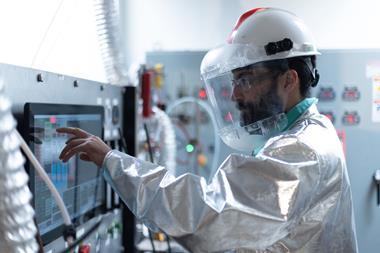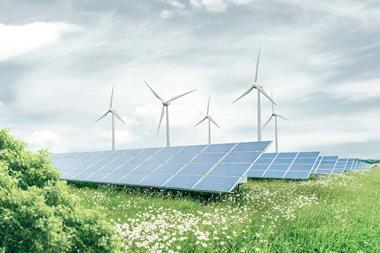
Lightweighting is a key factor in modern vehicle construction. The latest mainstream model to get the all-aluminium treatment is the new Range Rover, from Jaguar Land Rover. The third generation of the iconic SUV is bigger and has more leg room than its predecessor – yet it weighs an impressive 20% less. Its aluminium monocoque is reported to be 39% lighter than the current car’s steel and aluminium body panels.
And it’s not just the body which has been treated to lightweight materials. The traditional MacPherson struts in the front suspension have been replaced with aluminium double wishbones. This is the physical manifestation of the company’s commitment to a new way of working and of building its cars – keeping them luxurious while making them more recyclable, durable and less polluting than before. This weight saving is after the additional equipment, including luxurious seats and improved safety features, as well as upgraded in-car entertainment have been included. It is a measure of just how much aluminium can contribute to the search for lighter weight that the Range Rover can now consider using smaller engines. Hitherto, it has been a 40-year march from the Buick 3.5-litre V8 through to the current generation’s 3-litre BMW 6-cylinder diesel and turbocharged 4.4-litre TDV8, and maintaining the 5-litre version of the venerable petrol V8. The new edition starts with the big petrol V8 but it will be able to use the upcoming Jaguar 3-litre V6 and return more than acceptable performance, because of that lower weight – and the 3-litre TDV will offer customers sub-200g/km emissions unheard of for a Range Rover. In short, aluminium has enab led the new car to be bigger, cleaner and, crucially, lighter. Some steels, such as ultra-high strength grades, can be up to nine times the weight of aluminium. The advantage they have is that they are massively strong but, says Patrick Ward, senior metallurgist with Bentley: “The prime reason for using aluminium is lightweighting”. Bentley’s body panels use high formability grades, such as the 6000 series. They are solution-treated to take them from formable to hardened, which provides excellent dent resistance. Past issues such as the ‘oil-can effect’ have been overcome by technological solutions such as hardening, and by design – panels are now ‘crowned’ so they will resist denting. In particular, Bentley makes a lot of use of aluminium in its Continental/GT series. “Bentley uses aluminium quite a lot in bodywork, engines, subframes, wheels and in decorative trim”, continues Ward. “It is present in the bodywork of the Mulsanne, and in all closures except the boot lid. The GT has it on the boot, bonnet, front fenders, front suspension components such as uprights and rear subframe. The chassis on the Mulsanne tends to be steel pressings.” The company’s experience makes it acutely aware of the advantages and challenges of aluminium.
 Joined-up thinking
Joined-up thinking
“The major challenge with aluminium is joining”, confesses Ward. “We tend to rivet and adhesive-bond the doors on the Mulsanne. There are a limited number of MiG welds and virtually no spot welds; riveting and adhesive bonds keep the lines clean and correct pre-treatment helps to ensure that joining problems are overcome.” Joining two types of material, such as steel and aluminium, is not easy and welding just does not seem to work. Today’s body-in-white may feature up to 20 or 25 different joining technologies. Spot welding is still the most prevalent roboticised joining method in the industry but, as Ward indicates, not so much in aluminium structures, where adhesives and riveting have larger shares. Joining is such a vexed issue that there are some who actually think of it as the greater challenge. “More advances are needed in joining than in materials”, says Tony Norton, senior director of global automotive and off-highway vehicles at design technology company Altair. “We probably have all the materials we require but we do not have all the jointing technology we need. The adoption of mixed materials will be held back until we get to the technology that can join aluminium to steel, to composites or to plastics.” Morgan and other manufacturers, including Rolls- Royce, Bentley and Aston Martin, have overcome potential challenges of joining panels and working the metal by adopting panels produced by Superform, which uses a hot forming process in which a sheet of aluminium (or magnesium or titanium) is heated and then forced onto or into a single-surface tool to create a complex three dimensional shape from a single sheet. The company, based in Worcester, UK, offers a range of five superforming processes: cavity, bubble, back pressure, diaphragm and vacuum furnace. The Morgan’s sweeping wings and fenders are produced in single pieces using the technique.
Commitment to the right mix
Automobiles today are made up of a mixture of materials within the body structure. The difficulty of joining different metals together, in particular, means companies must think long and hard before switching to lightweight materials – the switch then has to be wholehearted or it will not work. “While aluminium is being used more widely in auto manufacture, it is being held back by the same thing that has held plastics back”, says Norton. “It is very easy to do a simple replacement – change a steel boot lid to aluminium, for example – but if times get hard and the company wants to save money it will go straight back to steel.” And it cannot be denied that aluminium is, initially at least, more expensive certainly than lower grades of steel. It can also require more energy to work it, although the issues are not quite as clear cut when it comes to recycled material. But the point remains: effective change requires commitment. “If you have a lot of parts that are just pure material replacement, and you don’t change the structure of the vehicle, the new material does not become embedded or part of the process”, Norton continues. “Integrating the new material into the vehicle is very core part of bringing it to market. Jaguar is the best example of complete investment in a new vehicle structure, and aluminium is now core to the way they build their cars, how they structure and manufacture. That is a big change. You can see that with the release of the new Range Rover, where the whole body in white is changed.” Audi also builds all-aluminium cars and has been doing so for longer than Jaguar Land Rover – from its 1994 Audi Space Frame A8 onwards – but it is no less valid to note how Jaguar Land Rover has switched and committed to aluminium. Norton goes further and emphasises very clearly that the full advantage, weight saving and cost benefits will not be won without full integration. “If it is just a substitute, if it looks like an indulgence, then if times get tough, the company will go back to where it came from”, he explains. Effective integration offers the potential for real steps forward in efficiency and effective operations, as well as better build quality and easier manufacture. Norton mentions that the inner panel of the door had traditionally been made of stamped steel. It then had a lot of clips attached, to hold wiring, the speaker, and so on. A switch to a plastic inner means that all those work-intensive clip-ons can be moulded-in, creating a single piece. It goes from being mere substitution to a new and more effective component. That, of course, requires investment in new machinery which is a doubleedged blade. On the one hand, there is resistance to big capital investment, especially amid ongoing economic uncertainty. On the other hand, get the new equipment and the accountants will want it to be used, which means that the designers and engineers will be under more pressure to integrate everything.
Going all the way
“There is an element of ‘we have paid for this machine and we are going to use it”, Norton agrees. “There is also inertia as well. The industry has been building steel cars for 100 years and there is a lot of inertia. They have had a lot of practice at manufacturing steel parts; bring in new materials and you add complexity. The infrastructure needs to change, so the change has to be driven by the supply chain, as well as by the OEMs.” The change in equipment is very visible at Jaguar Land Rover’s factory in Solihull, where the new Range Rover is being built. There is very little welding with the aluminium Range Rover: it is glued, bonded and riveted using what we are advised are the world’s first self-loading rivet guns. As with the challenges of metal joining, there are other issues to deal with – not least, painting.
Auto manufacturers have invested a great deal in welding technology over the years. The capital committed to welding robots represents both remarkable value for money – some of the machines have been working 24/7/365 for decades – and an inertial damper on the adoption of aluminium.
Aluminium is nowhere near as easy to weld as steel. It has quite a low melting point, which coupled with high heat conductivity, leads to a very fi ne line between no penetration at all and damage to the metal. It forms a hard oxide layer, which has to be removed and the exposed metal cleaned very shortly before welding.
Removal and cleaning is quite simple but it is an added complication and cutting or fi ling can produce fl ammable aluminium dust, which forms highly explosive thermite in the presence of steel dust. Arc welding aluminium to other metals, such as steel, leads to the formation of very brittle intermetallic compounds.
To recap, aluminium is sensitive, does not mix well with others and its dust is a safety hazard. But welding it is not impossible. Various techniques have been developed to isolate the other metal from molten aluminium during the arc welding process, in order to avoid formation of brittle compounds. The two most common methods are bimetallic transition inserts and pre-welding coating of the other metal.
Explosion welding involves the joining of materials by pushing them together under extremely high pressure. The process is commonly used for aluminium with steel in ship hulls or compound plates. A bimetallic strip, formed of explosively-welded aluminium and steel, is an alternative.
TIG (tungsten inert gas) can be used to join aluminium to itself. Other solid-state welding processes include friction stir welding, which uses a wear-resistant rotating tool to create welds below the melting point in the solid phase. Resulting mechanical properties and low distortion are attributed to the low heat input and the absence of melting. However, the joining technique that seems to be preferred in auto manufacture is riveting and bonding, which are well established and have a strong supply infrastructure.
Painting problems
“Everyone wants a nice coat of paint but getting paint to stick to aluminium is a key problem”, admits Ward. “Steel bodies are put through a phosphate bath, electro-coated, then primed and finished with the colour. The key feature that delivers paint adhesion is the phosphate solution. Aluminium is different from steel. The make-up of the phosphate solution needs to be specially tailored but the other challenge is that anything that tends to be good at sticking to aluminium can also be environmentally nasty. We have to put things through a process to make them more environmentally acceptable.” Bentley buys in pre-treated aluminium sheet with a titanate coating, less than three microns thick. The makeup of the phosphate solution is adjusted to cope with the mixed-material body. “Certain additions are made by our suppliers, at our instructions. We have to tailor the make-up of the bath so that it works with steel and aluminium,” he explains. Exactly what the tweaks are remains confidential but the environment is a consideration and the more challenging nature of the compounds being used means investment in new paint shop technology; not a cheap undertaking, but an essential one. “Ultimately, environmental responsibility lies with Bentley”, says Ward. “The laws within the EU dictate what we can use and we work with our suppliers to ensure we are environmentally compliant. There is a price to pay but, to be fair, that is less of a consideration with Bentley than would be the case with mass-market producers. “If we actually wanted to make the car really cheaply, we would probably steer clear of aluminium and stick to steel pressings. But if the performance of the car is going to be optimised then weight must be kept as low as we can manage.” In terms of environmental efficiency, he observes that ‘steel people’ and ‘aluminium people’ will both maintain that theirs is more environmentally and energy efficient, and each will have a bank of facts and data to prove it.
The mark of class
Whatever the application, it seems that aluminium is restricted in large-scale applications to premium cars such as Range Rover, Jaguar XJ and upper-end Audis, as well as the chassis of the BMW i3 concept, which represents a return to the chassis-plus-separate bodywork structure that was commonplace before subframes and monocoque concepts became widespread. There is no doubt that steel is cheaper and, as Norton says, the infrastructure has been there for 100 years. Making this huge change is not straightforward and, in the case of mass-market vehicles, the additional expense is probably not worth it – and the capital investment requires serious thought – so aluminium is likely to be largely restricted to the higher end market for the foreseeable future.


































